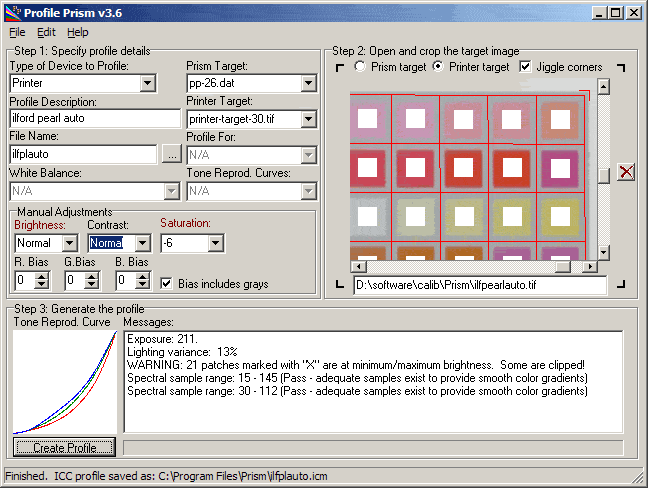
PROFILE PRISM - REVIEW
Profile Prism enables you to calibrate scanners, cameras and printers by generating profiles for use in colour managed software such as Photoshop and Qimage. I am mainly interested in profiling my Epson 1290, which is equipped with a continuous inking system to use bulk 3rd party inks.
I ordered it from http://www.ddisoftware.com/prism/ at $69. This translated to a Visa bill of £44.18. There was then a Customs and Excise charge of £10.40 stuck to the delivery envelope, but the postman did not actually ask for payment. Included in the package were the CD, colour reference chart and half a page of quick start instructions.
USING THE SOFTWARE
The software is very easy to use: you first make a print of a special colour chart and then scan it in alongside a supplied reference print. Then in Profile Prism, you open the image from the scan and set markers to identify the corners of the charts. The generator then compares the two charts and evaluates the differences to produce the custom profile. This took less than one minute on my 1.2GHz machine. As an alternative to scanning, you can photograph the prints with a good digital camera.

When printing the colour chart, it is important to switch colour management off and avoid any automatic image adjustment features. On Epson printers, this means using either the "No Colour controls" or "Automatic" modes. The former gave a very dark print and is not recommended - the profile generated using it had a very strong yellow cast. The print from the Automatic mode is lighter and works much better.
A good scan is imperative for good results so care must be taken to avoid over/under exposure. The software reports any imperfectly printed/scanned colour patches and I have not so far succeeded in a completely error free run. Fortunately, this does not seem to prevent a good profile from being generated.
After a profile has been tested, it is easy to rerun the generator with tweaks to brightness, contrast and overall colour balance in order to improve the profile. Only global alterations are possible.
RESULTS
Results have so far been a mixed bag - adequate but not perfect. Mostly, the colours have been quite good (after a bit of tweaking, that is; all the profiles generated have had a brownish cast initially). Greyscales were not as neutral over the whole range as one would like. I have had generally good results on Olmec Matt, Jessops Photo Paper, Ilford Galerie Classic Pearl, and Tetenal Archival Matte. So, although the results are encouraging, I think a profile editor with more powerful features is needed to finish off the job and produce a better result. I'm told enhanced editing features are planned for future releases and users are entitled to free updates for a year.
In my tests I have used a Umax Astra 2500 scanner and Canon D60 digital SLR. I expected better results from the D60 than the scanner, which was a very cheap bargain buy at £28. In practice, there seemed little to choose between the two, though PP reported far fewer errors when using the D60 generated images.
For tweaking the profiles, I used the Color Darkroom plugin from www.antelligent.com and Doctor Pro from www.colorvision.com . I had problems initially with Doctor Pro, which would not process the profile generated by Profile Prism. Simply opening and saving the profile with the Color Darkroom plugin solves that problem.
Color Darkroom is especially useful for producing a good greyscale. I was able to get excellent b&w prints from all my profiles. Colour corrections are limited to overall colour balance and editing spot colours, the latter being used for the greyscale correction. Getting the greyscale really uniform takes some patience. You need to allow test prints to dry for 24 hours before assessing results. This this was particularly true of Epson Premium Gloss, which had very pronounced changes after a day or so. Other papers aren't nearly so bad, and getting a rough balance can be done fairly rapidly.
Doctor Pro works by applying an action developed in Photoshop to the profile. Most global colour corrections can be employed (including curves, levels etc). This enables the reds to be made more/less saturated or more orange, for instance. Even with Doctor Pro, corrections had to be something of a compromise. Tweaking one colour to get it absolutely right ususally caused some other colour to become less accurate.
Overall, I would rate the profiles I have generated as "serviceable". Their shortcomings show up in some prints, but generally they give quite pleasing results.
LICENSING CONSIDERATIONS
It should be pointed out that generated profiles are for the use of the license holder only, but they can be shared with other licensed users by downloading them to the Profile Prism ftp server.
Written by John Houghton
9th March, 2003
Email: j.houghton@ntlworld.com